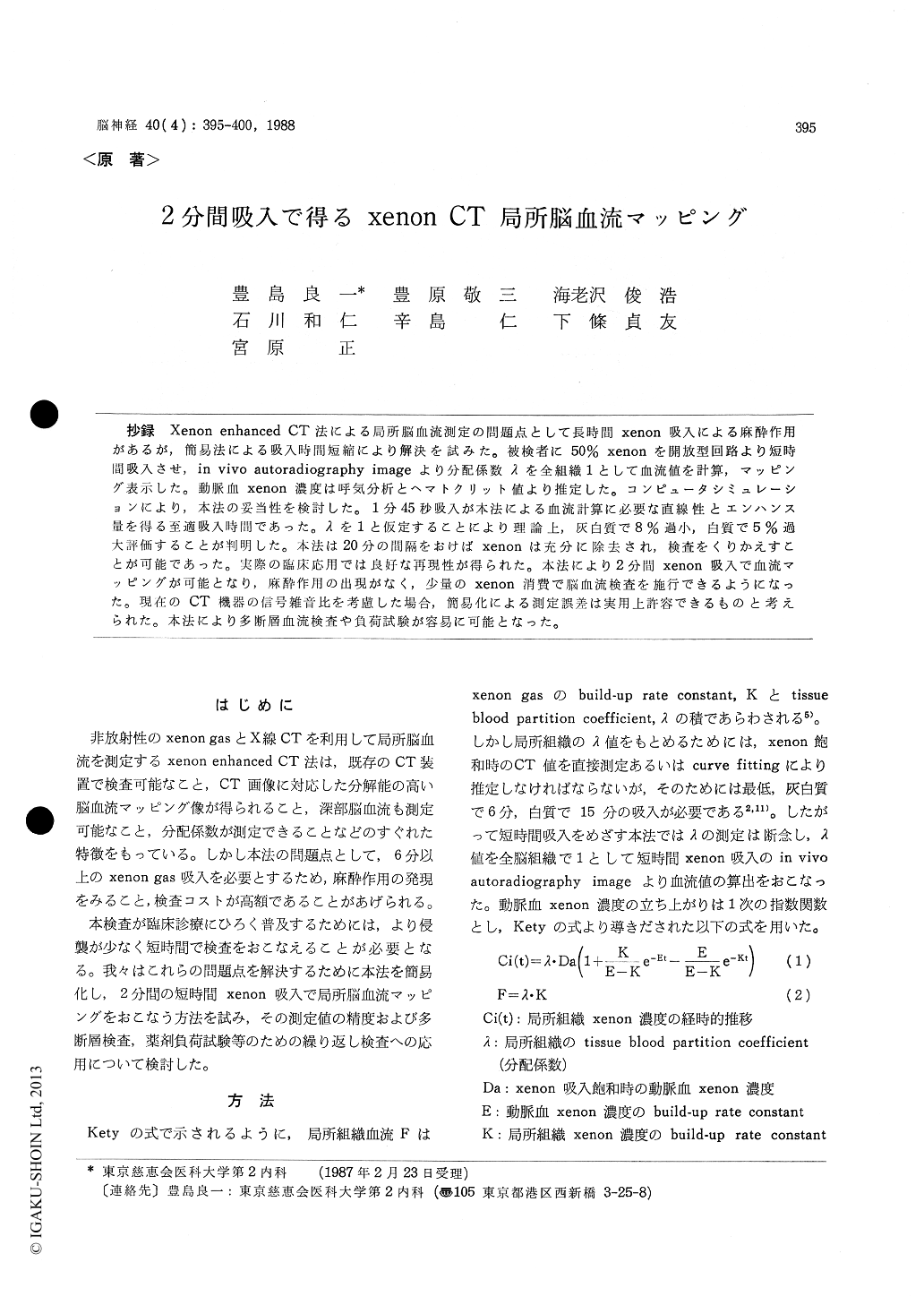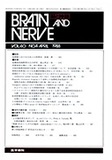Japanese
English
- 有料閲覧
- Abstract 文献概要
- 1ページ目 Look Inside
抄録 Xenon enhanced CT法による局所脳血流測定の問題点として長時間xenon吸入による麻酔作用があるが,簡易法による吸入時間短縮により解決を試みた。被検者に50% xenonを開放型回路より短時間吸入させ,in vivo autoradiography imageより分配係数λを全組織1として血流値を計算,マッピング表示した。動脈血xenon濃度は呼気分析とヘマトクリット値より推定した。コンピュータシミュレーションにより,本法の妥当性を検討した。1分45秒吸入が本法による血流計算に必要な直線性とエンハンス量を得る至適吸入時間であった。λを1と仮定することにより理論上,灰白質で8%過小,白質で5%過大評価することが判明した。本法は20分の間隔をおけばxenonは充分に除去され,検査をくりかえすことが可能であった。実際の臨床応用では良好な再現性が得られた。本法により2分間xenon吸入で血流マッピングが可能となり,麻酔作用の出現がなく,少量のxenon消費で脳血流検査を施行できるようになった。現在のCT機器の信号雑音比を考慮した場合,簡易化による測定誤差は実用上許容できるものと考えられた。本法により多断層血流検査や負荷試験が容易に可能となった。
Although xenon enhanced CT method for local cerebral blood flow measurement has been brought into a clinical practice, the technique has inherent limitations including anesthetic effects and expensive cost of xenon by a large consum-ption. To overcome these problems a modified-method with a short-duration inhalation was de-veloped and its validity was attested.
Siemens Somatom SF with a resolution of 256 ×256 pixels and a scan time of 10 seconds was used. The subjects inhaled 50% Xe/O2 gas mix-ture from an apparatus consisted of Douglas bag and an open circuit. Xenon concentration in the expired gas was continuously monitored and estimated for arterial blood concentration by using a hematocrit correction. PaCO2 was monitored throughout the study. At the starting point and the endpoint of the inhalation two scans were performed respectively. Thus obtained four im-ages were processed for CT noise cancellition, summation and subtraction to produce an in vivo autoradiography image. Local CBF was calculated from equations derived from the autoradiographic technique with a fixed partition coefficient of λ= 1. Computer simulation studies were performed to find the optimal scan point to obtain an auto-radiographic image and to estimate the calculation errors of this method.
One minute and forty-five seconds was found to be the optimal scan point to gain an auto-radiographic image in view of a balance between linearity of CBF/enhancement curve and total amount of tissue enhancement. The theoretical er-rors due to the assumption for a fixed partition coefficient were calculated to be 8 % underesti-mation for gray matter and 5 % overestimation for white matter. The study can be repeated in 20 minutes interval for xenon clearance. A total of 20 patients was studied by this method with a satisfactory result. Reproducibility of LCBF mapping was ascertained and further multi-level CBF study was performed. It is noteworthy that anesthetic effects of xenon were nearly negligible in all the cases studied.
It is well known that anesthetic effect is rea-dily observed in more than 5 minutes inhalation of xenon in the range of 30 to 50% concentra-tion while in the standard method more than 6 minutes of inhalation for gray matter and 15 minutes for white matter are required for the estimation of an accurate λ. For this reason we have abandoned measuring λ and devised shorter inhalation method for LCBF. In spite of unavoi-dable theoretical errors, this method is thought to be feasible for a clinical application consider-ing the fact that even the most recent CT equip-ment has yet not achieved to gain enough signal to-noise ratio for precise quantitative measure-ment. This simplified method can minimize the known anesthetic effects of xenon and reduce the cost of xenon and also shorten the time for a study. The method may be widely applied to those of multilevel CBF mapping and to the load-ing test for an evaluation of drug effect on LCBF.

Copyright © 1988, Igaku-Shoin Ltd. All rights reserved.


